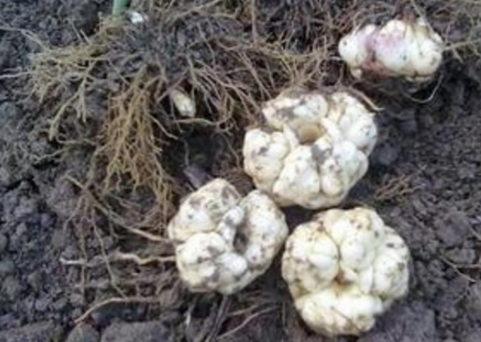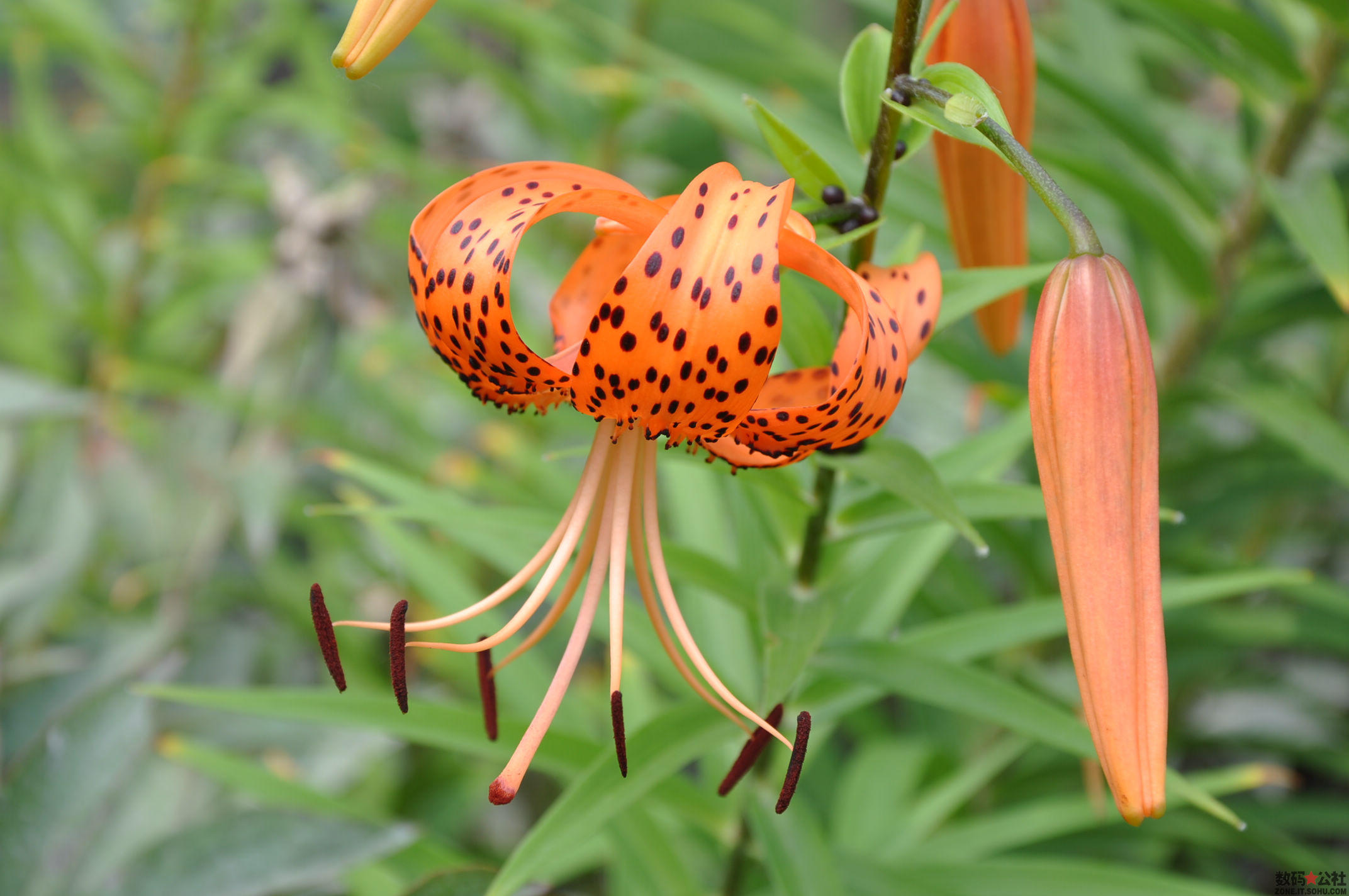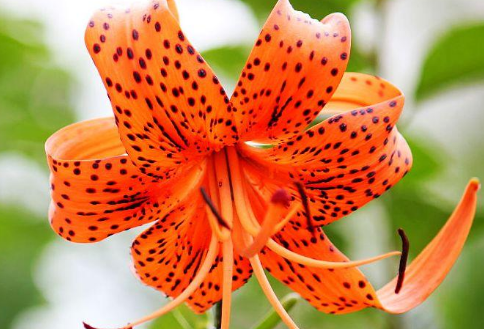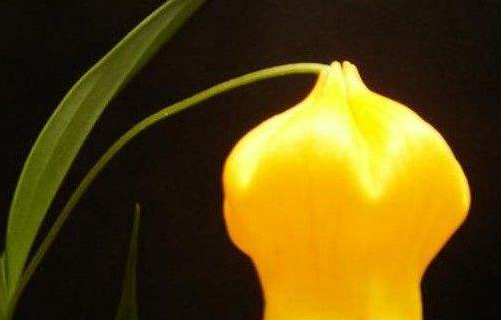Lilium Learn more about Lilium
-
Propagation methods of Lilium pubescens

(1) the growth and development of Lilium pubescens and habitats. In the cold Heilongjiang Province, the seedlings germinated as soon as the soil was thawed in late April. The most suitable environment for the growth of Lilium pubescens is roadside, forest gap, meadow and other soil and places with good water conditions and sufficient light. It is proved by investigation and experiment that when the light intensity is 50% to 100%, the growth of hairy lily is the best, the plant is stout, up to 80 to 130 cm high, the plant blossoms 1 to 12 per year, the fruit is full, and the scale is underground.
2019-01-16 -
Introduction to the ramet breeding method of Lilium lilium

Curly lily is an excellent variety of lilies. It is a perennial bulb flower with a unique shape and delicate beauty. It is a more formal variety of ornamental flowers. Artificial propagation of lily can use the method of ramet, because lily is a bulb flower, so its ramet is bulb.
2018-07-01 -
Propagation method of Lilium officinalis

The seeds were collected in autumn and stored in the spring of the following year. After a week of sowing, it can germinate. After germination, it should be properly shaded to avoid direct light and burns. Generally, small bulbs grow after autumn, and the bulbs can be dug out and planted in flowerpots. A plant raised in this way may blossom in one to three years.
2018-11-25 -
Culture methods and matters needing attention of Lilium lily

The lily lily is known as Curly Dan, inverted lotus, tiger skin lily, perennial herbaceous bulbous plant. Like warm, dry climate conditions, but also more resistant to sunlight. It grows luxuriantly in fertile sandy soil rich in humus and well-drained soil, with well-developed bulbs and colorful flowers. Suitable for nitrogen fertilizer, bean cake and vegetable cake
2018-12-30 -
Planting technique of Longya Lilium

Longya lily generally refers to Longhui Longhui, which is a specialty of Longhui County, Hunan Province and a national geographical indication product of China. Its planting in Longhui has a long history and its planting technology is more mature. Let's learn more about the planting technology of Xialong tooth lily. Longya lily planting
2020-11-09 Dragon teeth lilies implants techniques dragon teeth generally refer to Longhui -
Lilium lily diseases and their control methods, 5 major diseases / drugs are effective.

In the growth process of Lilium lily, if we are not careful enough, it is easy to let the disease take advantage of the disease. This kind of problem will not only affect the ornamental of the plant, but also lead to the phenomenon of withering and dying when it is serious. So how to do the disease and control methods of Lilium lily?
2018-12-09 -
Lilium Culture method of Beautiful but not vulgar Perfume

Lilium Culture method of Beautiful but not vulgar Perfume
2019-02-28 -
How to plant lilies to increase yield

Lily, scientific name (Lilium brownii var. Viridulum Baker), also known as Qiangshu, chives, Shandan, inverted immortal, Chongmai, atrium, Moro, heavy box, Zhongfeng flower, lily garlic, master garlic, garlic brain potato, night lily, etc., belongs to the genus Liliaceae (scientific name: Lilium).
2020-11-08 Lily how to plant ability increase production lily scientific name Lilium -
Cultivation techniques of Palace Lantern Lilium

Palace lantern lily (Sandersoniaaurantiaca) is a bulb flower of Liliaceae, which is named because its flower shape and color is very similar to that of Chinese palace lantern. When it blossoms, it is like a string of lanterns hanging on the flower branches, setting off the green leaves. It is called Christmasbells in English because its florescence is at Christmas. Growth habits Palace Lantern Lily originated in South Africa, wet and rainy in summer, is its growing season, dry and rainless in winter, for its dormant period. Due to the palace lamp
2019-01-16 -
Lilium daffodil cold orchid

In 2000, Lan you grass was selected in Lipu County, Guangxi, with large roots and fine leaves. It is cultivated by Brother Lanyou Wei in Lipu. Up to now, thirteen seedlings of all sizes. Flowers are like lily petals. A cat with a short round tongue. Red mark on the tongue is more prominent, rare good flowers, as we all know, things are rare and beautiful to have collection value. I am very optimistic about the pattern, but the only drawback is that the color is not in place.
2018-02-27 -
Penicillium rot of Lilium bulb

The disease occurs in the process of storage and transportation of lily bulbs. Symptoms: in the early stage of the disease, dark brown disease spots and sunken spots are produced on the injured scales. After that, the disease gradually spread inward, resulting in slow dry rot of the bulb, which took several weeks to rot away. In the later stage of the disease, the disease produced cyan mildew, which were the conidiophores and conidia of the pathogen. The pathogen is Penicillium circularum (PenicilliumcyclopiumWestl.) And Penicillium bungeanum (P.C)
2019-01-16 -
Lilium pest control method

Lily pests are mainly aphids, beetles and so on. In addition, there are root-knot nematodes, ground tigers and other hazards. Aphids and peaches are the most common aphids in plants. Prevention and control: eliminate the source of overwintering insects, remove nearby weeds, and thoroughly clear the garden and fields. Spray 40% dimethoate or omethoate 1200 times, or aphid pine emulsion 1500 times, or 2.5% fish essence 1000 times 1500 times during the aphid damage period. To protect natural enemies is to protect seven-star ladybugs, aphid flies and lacewings. Grubs are the larvae of beetles, mainly
2019-01-16 -
Control of Lilium Leaf Blight

Symptoms: round or oval disease spots appear on the leaves, varying in size and more than 2mm in length. Light yellow to light brown. In some varieties, the spot is light brown, surrounded by a clear reddish-purple edge, and in wet conditions, the spot is quickly covered with gray mold.
2020-11-08 Species lilies leaf blight disease control symptoms leaves upper production -
Characteristic characteristics of Lilium chinense

Characteristics: Xiangshan chicken mouth Li fruit mature, the seed degenerated into a chicken mouth shape, so it is called chicken mouth Li. The plant of this variety is strong and tall, the tree shape is compact, the trunk is grayish brown, the crown is semicircular head shape, open, the branches are clustered, thin, hard, the leaves are medium large, long oval, dark green, glossy, the leaf margin is flat, and the tender leaves are purplish red. The ripe fruit is crooked heart-shaped or flat-shaped, uniform in size. The pericarp is thin and tough, dark red, the lobes are large and sparse, flat or papillary, arranged regularly, and the suture lines are wide and obvious.
2019-01-16 -
Key points of cultivation of Lilium chinense

Key points of cultivation: ① requires the selection of mountains, hills and flat land with deep soil layer and good drainage, planting in spring or autumn, planting specifications of 3 meters × 5 meters and 45 plants per mu. ② focuses on promoting shoot expansion of tree crown, using fertilizer and water management, applying frequently and thinly, and "one shoot and two fertilizers" continuously promote shoot growth. The number of branches was increased and the crown was enlarged. after 2-3 years of management, the crown reached 2 meters before hanging fruit. The natural round head shape is generally used in shaping and pruning, and the methods of coring, truncation, thinning and wiping buds are used to restrain shoot growth and promote branch division.
2019-01-16 -
Harvesting, processing and Medical function of Lilium

Harvesting and processing: from September to October, after the stems and leaves of the lily withered, the bulbs were dug, the residual stems and fibrous roots were removed, and the scales were peeled off (the bulbs were cut off and the scales were scattered naturally). Wash the soil and boil it in boiling water or steam it in a cage for 3 minutes. Remove quickly when the edge of the scale is soft, the middle is still alive, or there is a very small crack on the back. If there is any mucus, rinse with clean water, immediately spread it on the Reed mat and dry it thoroughly. In case of cloudy and rainy days, the Kang can be dried, and it needs to be turned over when drying to make it heated evenly. When flipping, hold it up with both hands and turn it over quickly.
2019-01-16 -
Nutrition Management of nitrogen and Iron deficient Lilium

The mesophyll tissue between the veins of young leaves is yellowish green, especially for fast-growing plants. The greater the amount of iron deficiency in plants, the more yellow the leaves become. Iron deficiency is the most common cause in calcium-rich soils (high pH), muddy soils and soils with too much water. Iron deficiency can also occur if the soil temperature is too low. Iron deficiency is caused by the lack of absorbable iron in plants. If it turns yellow only slightly, it can return to normal during the harvest period. Lily populations and varieties sensitive to iron deficiency include far East hybrids and musk lily hybrids.
2019-01-16 -
Growth characteristics of Lilium davidii

The main results are as follows: (1) the characteristic root of root and bulb is fleshy root, which grows from the bottom of bulb, and there is no difference between main and lateral root, which is also called "lower disk root". There are dozens of roots in the lower root, which has a strong ability to absorb nutrients in the soil and does not die every other year. The fibrous root is produced on the bulb, which is called "upper disk root". The upper root occurs late and distributes on the surface of the soil, which can fix and support the aboveground stem. The upper root dies at the same time as the aboveground stem every year. Bulb in soil, apically 3-6 cm from ground surface, composed of scales and short stems. The shortening stem is a conical disk.
2019-01-16 -
The Culture method of Curly Dendranthes

1. Codonopsis lanceolata likes acidic soil rich in humus and can be mixed with rotten leaf soil, garden soil and sandy soil. two。 Light curl Dan needs suitable light to grow well, the flowers are more beautiful, the sunshine in spring and autumn can meet the needs of the plant, and the light is strong in summer, so avoid direct light.
2018-11-25 -
Breeding methods of Palace Lantern Lilium

Seed reproduction and bulb reproduction are generally adopted. The palace lantern lily is delicate in appearance, exquisite and lovely, and the orange flower bell with bright green stems and leaves is very lovable. It is an excellent flower arrangement material and bride bouquet material with very high ornamental value.
2018-11-25
